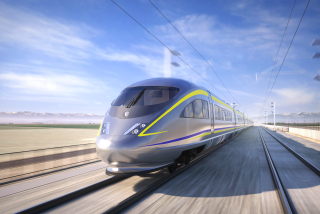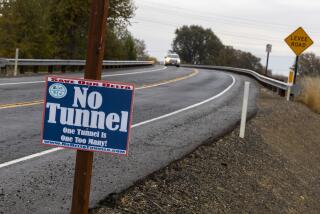Tollway green light is many stops down road
- Share via
During the next three years, the government agency planning a tollway through San Onofre State Beach must clear a thicket of regulatory hurdles before construction can begin.
The Irvine-based Transportation Corridor Agencies needs approvals from at least eight state and federal agencies to build the Foothill South toll road, a 16-mile highway that would cross the northern half of the popular coastal park.
Last month, TCA board members postponed the start of construction for the tollway from 2008 to early 2011 because of the complexity of the permit process.
“The schedule change has brought reality to the situation, but it is disappointing. We need to start construction today,” said county Supervisor Bill Campbell, a TCA board member.
Tollway officials must secure permits from the California Coastal Commission, state Department of Fish and Game, Army Corps of Engineers, state water quality regulators, the state Office of Historic Preservation, Federal Highway Administration and the Navy because San Onofre State Beach is on land leased from the Camp Pendleton Marine Corps Base.
Also of importance is a biological opinion that the U.S. Fish and Wildlife Service is preparing. If it finds that the project puts endangered species in jeopardy, it could threaten the proposal.
But the most difficult hurdle to get over might be the state Coastal Commission, which regulates development along the state’s vast coastline. Its staff already has expressed serious reservations about the Foothill South.
Deborah Lee, the commission’s deputy director, testified at a November 2005 hearing in San Clemente that the proposal violates state law and that commissioners would likely deny a development permit.
Mark Delaplaine, a Coastal Commission staff member analyzing the highway project, says the road threatens campgrounds, watersheds and endangered species, such as the Pacific pocket mouse.
“We have been on the record pretty strongly about the toll road,” Delaplaine said.
“It’s hard for me to see how they are going to get past the campground and pocket mouse issues. But maybe there are things the TCA can do. I need to remain open-minded.”
TCA board members said it was premature for commission staff to comment on the project when they had yet to receive the permit application.
“I’m disappointed that they are going in with the preconceived notion of failure,” said Mission Viejo City Councilman Lance MacLean, TCA board vice chairman. “Clearly we want to make this the most environmentally sensitive project we can. The process we have to go through will make the highway better.”
The Foothill South would run from Oso Parkway in Rancho Santa Margarita to Interstate 5 at Basilone Road, south of San Clemente. The cost estimate is $875 million.
Supporters say the tollway is needed to accommodate the region’s population growth and to reduce traffic on I-5, which is projected to increase 60% by 2025.
The Foothill South will complete the TCA’s network of turnpikes, which includes the Eastern, the Foothill and the San Joaquin Hills.
Opponents counter that the six-lane highway would irreparably harm San Onofre, a popular park that contains endangered species, unspoiled watersheds, archeological sites, pleasant campgrounds and world-renowned surf spots.
“It’s a bad idea,” said Assemblyman Pedro Nava (D-Santa Barbara), who unsuccessfully sought legislation last year to stop the tollway.
“I suspect when it gets to the commission, I will look for ways to express my opposition, including testifying.”
To help meet federal requirements and to secure permits from the Coastal Commission, the TCA authorized $1.15 million this month to hire legal and planning consultants. Tollway officials hope to submit the application within a year.
Once it is received, the commission’s staff will scrutinize the project to determine if it complies with the California Coastal Act and make recommendations to the commission, which must decide whether to grant a development permit.
The process can take years for major projects. There are often lengthy public hearings and discussions between agencies before final requirements are set for a development.
From his initial review of the project, Delaplaine says one key issue is the San Mateo Campground, which was given to the state by Southern California Edison in exchange for the loss of a bluff-top campground to make way for the San Onofre Nuclear Generating Station in the early 1970s.
The campground’s 162 sites, amphitheater and bathroom facilities would be 400 feet from the tollway.
“The campground is rare and unusual with links to surfing and other recreation,” Delaplaine said.
“There is no place like it between Gaviota [near Santa Barbara] and the Mexican border. The highway will ruin the experience.”
Delaplaine said the TCA’s plan to build a freeway ramp over the San Mateo Creek marine estuary is inconsistent with the state Coastal Act, which prohibits the sinking of concrete pilings into wetlands.
He also said the tollway would further jeopardize the endangered Pacific pocket mouse, which is on the verge of extinction.
Macie Cleary Milan, the TCA’s deputy director of environmental planning, said the agency would lessen the effects on the park with sound walls, landscaping, filters for highway runoff, and precautions to avoid habitats for endangered species. The public, she added, would still be able to enjoy the San Mateo Campground.
But TCA officials say they are worried about the time it will take to go through the approval process. The agency’s financial staff estimates that inflation will add $3 million to the cost of the project for every month of delay after the original 2008 start date for construction.
“The longer the wait, the worse the congestion will get on I-5. Pollution will get worse. The waste of time will get worse, and costs will grow,” said supervisor and TCA board member Chris Norby.
Norby is also concerned that Gov. Arnold Schwarzenegger has remained neutral on the tollway, which the state parks commission has opposed. “I would like him to come down here and say, ‘Let’s build it.’ His support would help.”
Norby and other TCA officials said they were guardedly optimistic about the Coastal Commission.
But if the permit is denied, the tollway agency can appeal to the U.S. Department of Commerce because the park is on federal land.
Such a move might add more uncertainty to the project if a Democrat wins the presidency in the 2008 election. A new secretary of commerce might not look as favorably on the tollway as his or her Republican predecessor. It is something Foothill South opponents are hoping for.
“That is not where we want to be with the Bush administration” in power, said Mark Massara, director of coastal programs for the Sierra Club.
But Jim Thor, a Rancho Santa Margarita councilman and TCA board chairman, said it was hard to guess what would happen if a Democrat is the next president.
Though generally more supportive of environmental protection than Republicans, Democrats might support the tollway because labor unions want the jobs it would create, Thor said.
“Their positions could flip-flop,” Thor said. “This is a great project. They need to come down here and walk the area to see the proposal for what it is.”
*
More to Read
Sign up for Essential California
The most important California stories and recommendations in your inbox every morning.
You may occasionally receive promotional content from the Los Angeles Times.














